What are pronouns?
Pronouns are words that a person may use to identify themselves instead of their name. A pronoun is a word that refers to either the people talking (I or you) or someone/something that is being talked about (she, it, them, and this). These are examples of personal pronouns. Whether a person uses she, he, or they, or anything else can depend on that person’s gender identity. It is important to respect people’s pronouns. You can’t always know what someone’s pronouns are by looking at them. Asking and correctly using someone’s pronouns is one of the most basic ways to show your respect for their gender identity.
For example, she/her/hers and he/him/his are examples of gendered pronouns. Some individual’s feel more comfortable with gender-neutral pronouns. The most common gender-neutral pronouns are they/them/theirs, used in the singular to refer to an individual in a way that isn’t gendered. Some people will use more than one set of pronouns, and you are encouraged to alternate among them in conversation. See below for specific examples of pronoun usage.
Gendered Pronouns
‘She/her/hers’ and ‘He/him/his’ are gendered pronouns. ‘She’ is typically used by those who were assigned female at birth (AFAB), women-identifying or femme-aligned people. ‘He’ is typically used by those who were assigned male at birth (AMAB), men-identifying or masc-aligned people. Both can be used by people who do not identify as either man or woman. For example: “I saw Sarah the other day. She left her bag in the lecture room”, or “Asish told me that he and his partner are on leave during semester break.”
Gender-neutral pronouns
Gender neutral pronouns are pronouns that are de-gendered and are typically used by gender diverse and non-binary people. There are lots of other gender-neutral pronouns and it is important to use the right ones. ‘They, them, theirs’ are common gender-neutral pronouns. These are pronouns that do not imply a gender such as man or woman. For example: “Jamie says that they wanted to come to the meeting, but their calendar was just too busy today.”
Some people may ask that you use a combination of pronouns, such as ‘she/they’ or ‘they/he’ – this means that this person is comfortable being referred to using more than one type of pronoun, and that they would like people to use a mix when referring to them. If you are unsure of what pronouns to use when an individual is comfortable using multiple pronouns, just clarify by asking. For example: (One day during a Zoom call): “Stef has their hand up” and (On a different day in a tutorial): “Stef said he just needed to go to the bathroom.”
Neopronouns
Neopronouns are a category of new (neo) pronouns that are increasingly used in place of “she,” “he,” or “they” when referring to a person. Some examples include: xe/xem/xyr, ze/hir/hirs, and ey/em/eir. Neopronouns can be used by anyone, though most often they are used by transgender, non-binary, and/or gender nonconforming people. See table below:
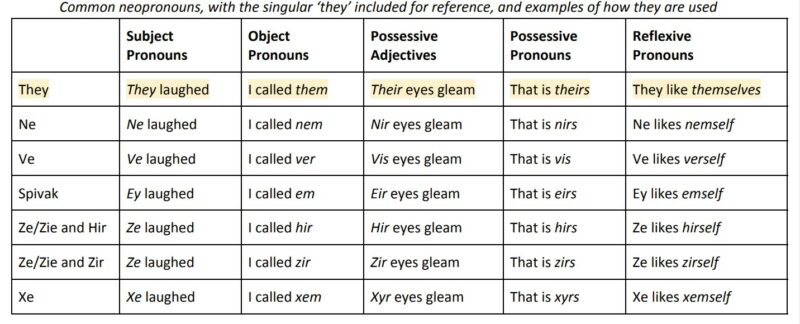
Table 1: Neopronouns in conversation (UNC Greensboro, 2019)
No Pronouns
Some people may not use any pronouns at all. If an individual/patient expresses to you that they do not use any pronouns, ensure that you ask the individual/patient how they would like to be referred to and follow their stated needs for the duration of your interaction with them. Sometimes those who do not use any pronouns use their name in place of gendered (she/he) or gender-neutral pronouns (they/etc). An example of this is for a patient whose name is “Lan”: “Lan presented to Sunshine Hospital ED. Lan informed the doctor of Lan’s concerns about Lan’s arm. Lan required an X-ray and was nervous as Lan had never had an X-ray before. Lan was relieved to be told that Lan’s arm was not broken, however, Lan did have a bad sprain”.
Misgendering
Misgendering is a term used to describe accidentally or intentionally using incorrect pronouns about or towards a person. Using new pronouns for a person can take some getting used to. Some can sound pretty strange, and changing the words you are used to using can be harder than expected. Slipping up can feel pretty awkward or even make you feel guilty, but it’s really important not to get upset or make a huge deal out of it if you do slip up in conversation. Just keep trying your best and move on. You’ll get the hang of it with time and practice! Misgendering can happen by accident, and that is okay – you can apologise and correct yourself, or ask what pronouns the person uses. However, when it happens intentionally and/or repeatedly, this is considered unacceptable workplace behaviour. If you have experienced this or have witnessed someone being treated in this way, please seek support.
Resource Link: Western Health Prevention of Bullying & Harassment Intranet Resources
What Are Pronouns?:
Why are pronouns important?
It’s not always easy to come out and tell people you’re transgender or that you use a new set of pronouns, so putting in the effort to use the right ones can have a substantial positive impact on the individual. If someone happens to use pronouns that are different to what you might expect, it is important to respect their pronouns and use them within conversation, even if that individual isn’t present. For many transgender and gender diverse people, having people know and use their correct pronouns is an important and validating part of their gender affirmation. The Australian Human Rights Commission (AHRC) (2019), recognises that terminology can have a profound impact on a person’s identity, self-worth and inherent dignity. The use of inclusive and acceptable terminology empowers individuals and enables visibility of important issues (AHRC, 2019).
Pronouns are not a ‘preference’
Avoid asking people what pronouns they ‘prefer’. Having a ‘preference’ can sound as if gender identity is a choice and most people do not feel as if they have a choice in these matters. If you need to, you can simply ask people what pronouns they use. When we talk about gender, sex characteristics or sexuality, we’re not talking about preferences or choices. We’re just talking about how people are.
Best Practice for Using Pronouns in the Workplace
-
Small things you can do to make a difference
- Practice, practice, practice! Start trying to use the correct pronouns where possible.
- Never assume someone’s pronouns from the way they dress or from their name.
- Remember to always ask people how someone would like to be referred to when you are speaking to them.
- Know that it is likely you will make a mistake. If so, apologize, correct yourself, and move on.
- If you’re in doubt about someone’s pronouns, just use their name.
- Privacy! We all have a right to privacy. People have the right to disclose about their sexuality or gender identity in their own time and on their own terms.
- If you hear someone using the incorrect pronoun you can gently correct them.
- Avoid assuming people’s gender identity (who they know themselves to be on the inside) based on their gender expression (what they present on the outside).
- If you are in a group setting or a meeting, avoid using gendered terms like guys or ladies; try using neutral terms like people, folks, everyone, friends, colleagues, team, pals, crew, peers or companions.
- The best way to avoid mistakes is to practice using gender-neutral pronouns at every opportunity and by always asking the individual for their used pronouns.
- Educate yourself by using our glossary for definitions of different terms related to gender identity, gender expression and social justice.
- Normalise the sharing of pronouns at the beginning of a conversation or meeting.
-
Displaying your pronouns
Another great way to show support for the LGBTQ community as an ally is to display your pronouns publicly at your workplace. This shows that you take correct pronoun usage seriously and also encourages any gender diverse team members and patients to be more confident in being themselves around you and your organisation. Here are some great places that you can add your pronouns to:
- Sticker/pin on name tags & lanyards
- Badge/pin on uniforms
- Email signature
- Social media profiles
- Zoom & Teams backgrounds
- Displayed name in video calls
- Business cards
- Introductions/networking
- Intake forms
-
Western Health Pronoun Inclusive Email Signature
Jane Citizen
Public Affairs AdvisorPhone: (03) 0000 0000 | Mobile: 0400 000 000 | Email: jane.citizen@wh.org.au
Pronouns: She/Her
Western Health, Furlong Road, St Albans VIC 3021
www.westernhealth.org.au
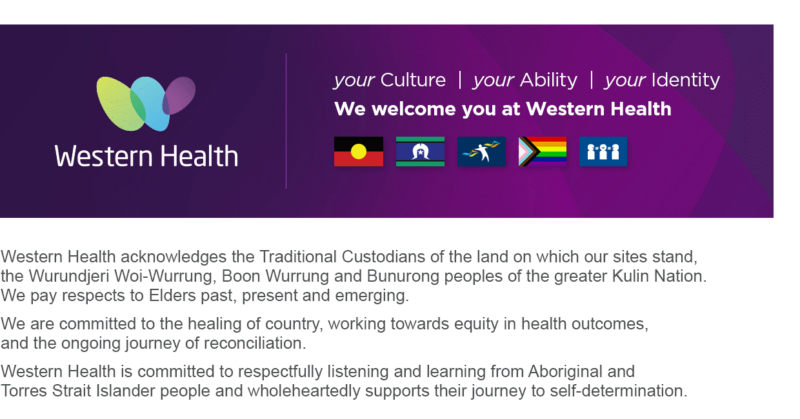
-
Western Health Pronoun Zoom/Teams Backgrounds
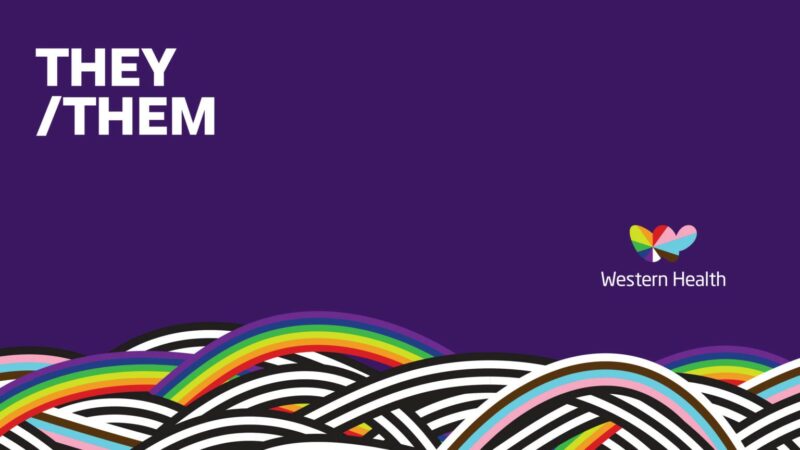
Download file 
Download file 
Download file Need helping changing your virtual background?
Click here for a video guide.You will need to download one of the background images above and save it to your computer, so that you can upload it to your virtual backgrounds. If your preview image isn’t showing up the right way around, make sure you unclick the button that says: ‘mirror my screen.’
-
Add your pronouns to your Microsoft Teams Profile
The pronoun setting in Microsoft Teams is a valuable feature that allows users to express their gender identity via pronouns within the platform. It’s a simple yet important tool for promoting inclusivity, gender equality and respectful communication in a respectful & diverse workplace. This document describes the process of setting up pronoun within the Microsoft Teams application.
Steps to setup your pronouns in Microsoft Teams
- Access your profile: On the Teams application, click on your profile picture or the initials of your name at top right corner.

- Edit Profile: In the drop down menu, click on your name/email address.
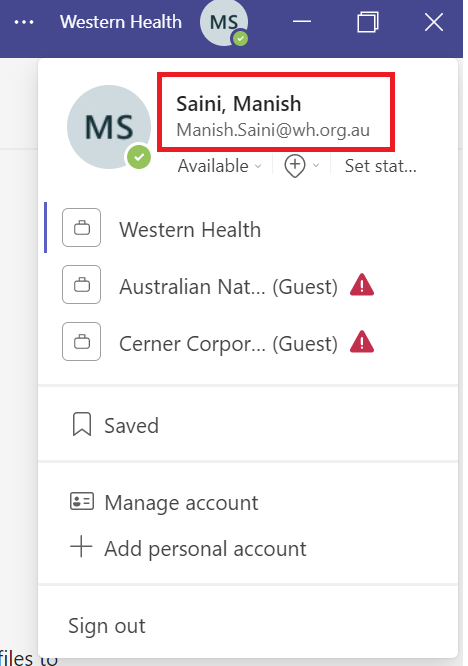
- Add pronouns: Click on + Pronoun.
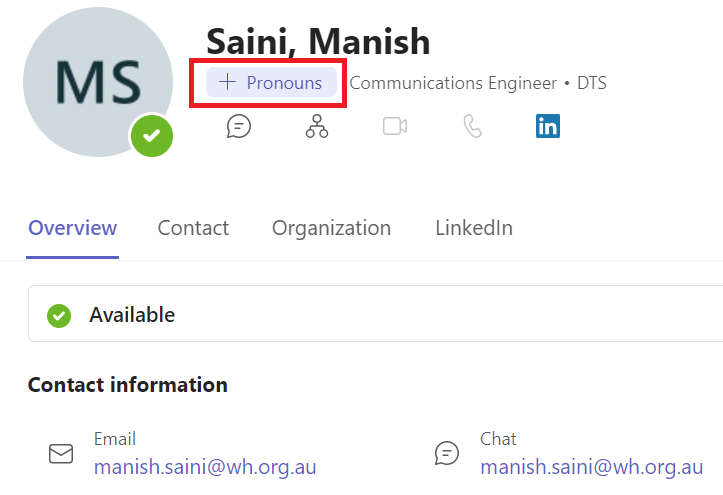
- Enter your Pronouns: In the pop-up window, type your pronouns. For example, you can enter “he/him,” “she/her,” “they/them,” or any other pronoun you prefer.
- Click on Save
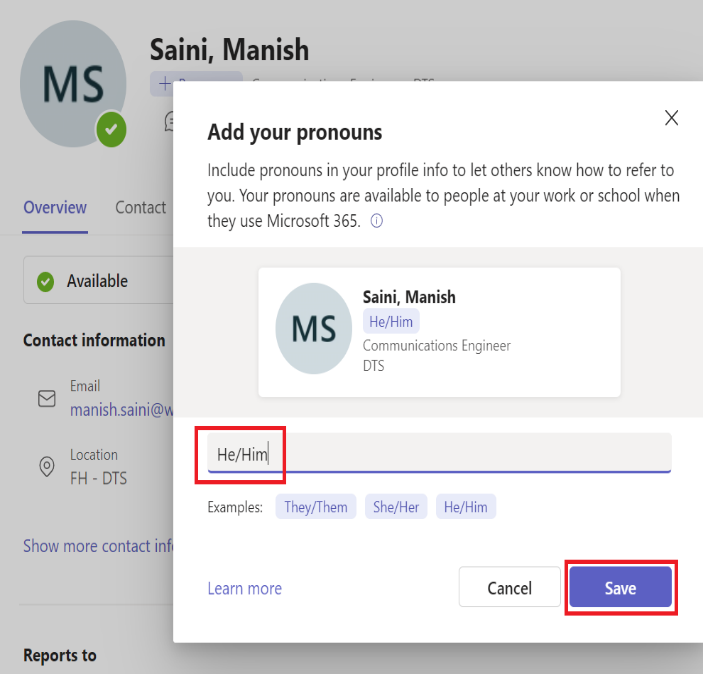
- Access your profile: On the Teams application, click on your profile picture or the initials of your name at top right corner.
-
Additional pronoun resources
- Minus18 Pronoun Practice Game
- ACON: Pronouns 101 – ACON Pride Training
- Say It Loud: Language Guide – Say It Out Loud
- IDAHOBIT: A guide to using pronouns at work
- Minus18: What are pronouns and why are they important? | Minus18
- International Pronouns Day: Pronouns.org Resources on Personal Pronouns
- Transcend Australia: Pronouns and Terminology
- Victorian Government: LGBTIQ+ Inclusive Language Guide
- Australian National University: Pronouns fact sheet – Staff Services
- RMIT University: lgbtiq/guide-inclusive-language
- Queensland Human Rights Commission: why-pronouns-matter
- Harvard Business Review: How to Talk About Pronouns at Work: A Visual Guide
-
References
- Australian Human Rights Commission. A note on terminology – Addressing sexual orientation and sex and/or gender identity discrimination: Consultation Report (2011) Accessed in July 2023. Retrieved from: https://humanrights.gov.au/our-work/section-3-note-terminology-addressing-sexual-orientation-and-sex-andor-gender-identity
- Gender-Neutral Terms for the Workplace & Beyond, 2022. Accessed in July 2023. Retrieved from: https://www.inhersight.com/blog/diversity/gender-neutral-terms
- Gender Pronouns & Why They Are Important. Accessed in July 2023. Retrieved from: https://www.pcadv.org/resources/gender-pronouns-and-why-they-are-important/
- Minus 18. What are pronouns and why are they important? Accessed in July 2023. Retrieved from: https://www.minus18.org.au/articles/what-are-pronouns-and-why-are-they-important
- University of North Carolina at Greensboro. Neopronouns Explained, 2019. Accessed on July 2023. Retrieved from: https://intercultural.uncg.edu/wp-content/uploads/Neopronouns-Explained-UNCG-Intercultural-Engagement.pdf
- ACON. Pronouns 101, 2023. Accessed on July 2023. Retrieved from: https://www.pridetraining.org.au/pages/pronoun-page
- Australian National University. Pronoun Fact Sheet. Accessed on July 2023. Retrieved from: https://services.anu.edu.au/human-resources/respect-inclusion/pronouns-fact-sheet
- Victorian Government. LGBTQI+ Inclusive Language Guide, 2023. Accessed July 2023. Retrieved from: https://www.vic.gov.au/inclusive-language-guide
We acknowledge that gender equity work is not binary. Gender inequalities impact people that identify with all genders, and its impact may differ tremendously in its cause, course, and have implications for people’s well-being. The work aimed towards inclusion, diversity and equity is ever evolving as well as the field itself. If you have any concerns, doubts, or comments about Western Health’s Gender Equality program and/or work, please do not hesitate to contact us.

